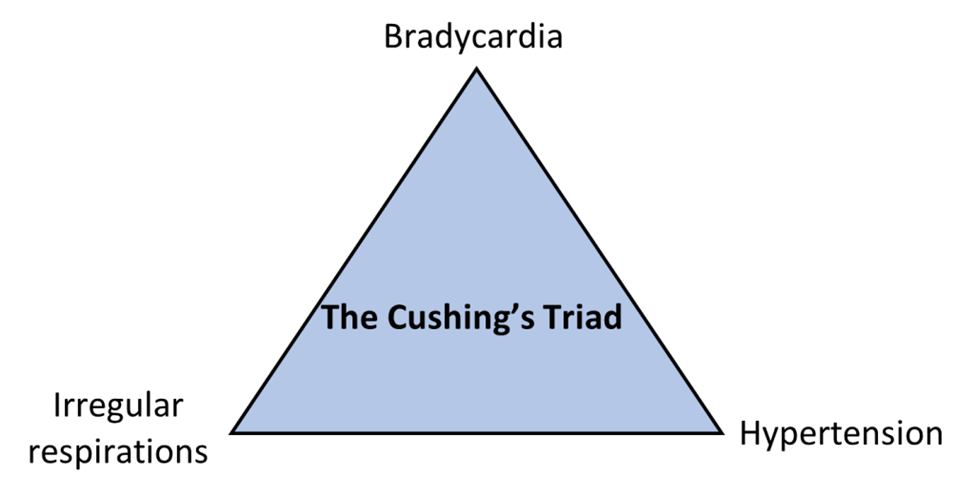Which three symptoms are characteristic of Cushing triad associated with increased ICP?
Bradycardia, hypertension, and widening pulse pressure
Widening pulse pressure, headache, and seizure
Hypertension, tachycardia, and headache
Hypotension, tachycardia, and narrowing pulse pressure
The Correct Answer is A
A. Bradycardia, hypertension, and widening pulse pressure
This combination of symptoms is characteristic of Cushing's triad. Bradycardia (slow heart rate), hypertension (elevated blood pressure), and widening pulse pressure (difference between systolic and diastolic blood pressure) are indicative of increased ICP, specifically resulting in the compression of brain structures that regulate vital functions.
B. Widening pulse pressure, headache, and seizure
While headache and seizure may occur in patients with increased ICP, widening pulse pressure alone is not sufficient to meet the criteria of Cushing's triad. The presence of bradycardia and hypertension, along with widening pulse pressure, is more indicative of Cushing's triad.
C. Hypertension, tachycardia, and headache
Hypertension and headache may occur in patients with increased ICP, but the absence of bradycardia and widening pulse pressure makes this option less characteristic of Cushing's triad.
D. Hypotension, tachycardia, and narrowing pulse pressure
Hypotension (low blood pressure) and narrowing pulse pressure are not typically associated with Cushing's triad. Tachycardia (rapid heart rate) may occur in response to increased ICP, but it is usually accompanied by bradycardia rather than hypotension.

Nursing Test Bank
Naxlex Comprehensive Predictor Exams
Related Questions
Correct Answer is A
Explanation
A. The client should maintain systolic BP between 120 and 129 mm Hg.
This is an appropriate recommendation. The American Heart Association (AHA) guidelines recommend maintaining systolic BP below 130 mm Hg to reduce the risk of stroke and other cardiovascular events in individuals with a history of stroke or TIA.
B. The client should maintain systolic BP between 130 and 135 mm Hg.
This is slightly above the recommended range. While systolic BP below 135 mm Hg is generally recommended for individuals with a history of stroke or TIA, a range of 130-135 mm Hg may still be acceptable based on individual patient factors and risk assessments.
C. The client should maintain systolic BP between 136 and 140 mm Hg.
This is above the recommended range. Systolic BP between 136 and 140 mm Hg may be considered elevated and should be managed to lower levels to reduce the risk of recurrent TIA or stroke.
D. The client should maintain systolic BP between 141 and 145 mm Hg.
This is above the recommended range. Systolic BP above 140 mm Hg is generally considered elevated and should be managed to lower levels to reduce the risk of recurrent TIA or stroke.
Correct Answer is ["A","B","D"]
Explanation
A. Provide a suction setup at the bedside:
This is a relevant intervention as it ensures that suction equipment is readily available in case the client experiences excessive secretions or vomiting during or after a seizure. It helps maintain a clear airway and prevent aspiration.
B. Elevate the side rails when in bed:
Elevating the side rails can help ensure the client's safety during a seizure by preventing falls from the bed. It is a preventive measure to minimize the risk of injury.
C. Place a bite stick at the bedside:
Placing a bite stick at the bedside is not a recommended intervention. Bite sticks can potentially injure the patient's teeth or mouth during a seizure and are generally not recommended in current practice.
D. Keep an oxygen setup at the bedside:
This is an appropriate intervention as it ensures that oxygen is readily available in case the client experiences respiratory distress or hypoxia during or after a seizure. Oxygen therapy may be needed to support respiratory function.
E. Furnish restraints at the bedside:
Furnishing restraints at the bedside is not a recommended intervention for managing seizures. Restraints should only be used in exceptional circumstances when the client's safety or the safety of others is at risk and should be applied according to institutional policies and legal regulations.
Whether you are a student looking to ace your exams or a practicing nurse seeking to enhance your expertise , our nursing education contents will empower you with the confidence and competence to make a difference in the lives of patients and become a respected leader in the healthcare field.
Visit Naxlex, invest in your future and unlock endless possibilities with our unparalleled nursing education contents today
Report Wrong Answer on the Current Question
Do you disagree with the answer? If yes, what is your expected answer? Explain.
Kindly be descriptive with the issue you are facing.
